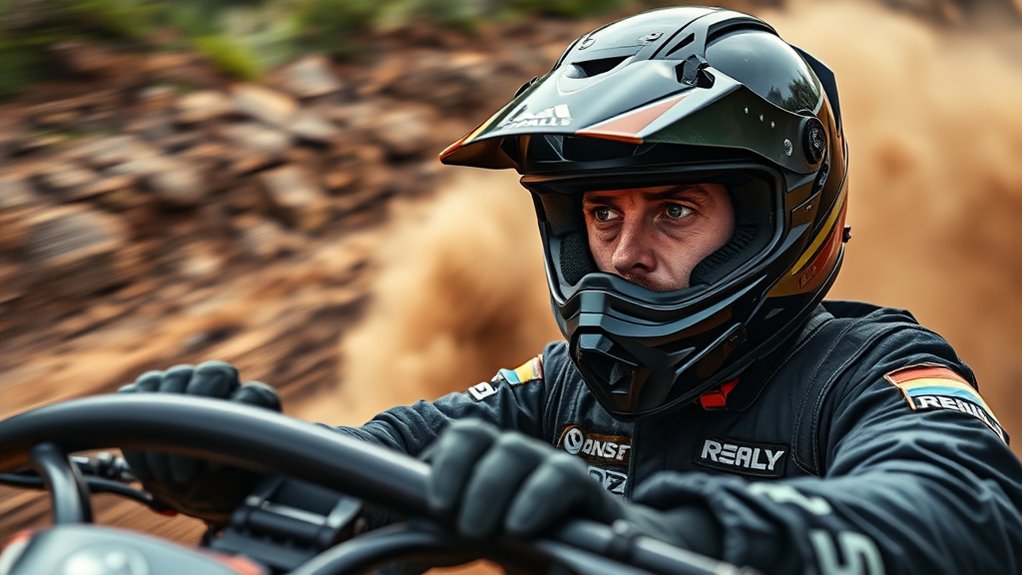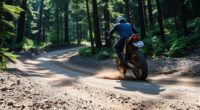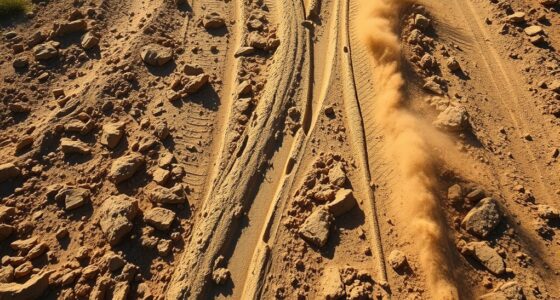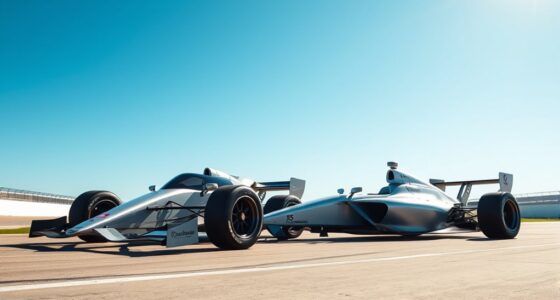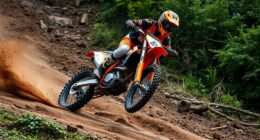Professional rally riders enhance reaction time through a mix of visual reflex drills, like tracking moving objects and using stroboscopic glasses, along with high-intensity exercises that respond instantly to stimuli. They practice simulator scenarios that mimic unpredictable terrain and hazards, while combining rigorous physical conditioning to stay alert and focused. Mental strategies, like visualization and quick decision-making, further sharpen their responses. Keep exploring to discover more ways to boost your reaction speed just like the pros.
Key Takeaways
- They incorporate stroboscopic glasses and tracking drills to enhance visual processing speed.
- They perform high-intensity reaction exercises with flashing lights and sudden stimuli.
- Simulator training replicates real-world hazards to improve instinctive responses.
- Physical conditioning, including endurance and flexibility, supports quicker reactions during races.
- Mental focus practices like visualization and scenario-based drills sharpen decision-making under pressure.
Drills to Improve Visual Reflexes

To enhance your visual reflexes, incorporating specific drills into your training routine can make a significant difference. One effective exercise is the stroboscopic training, where you wear glasses that intermittently block your vision, forcing your eyes to process information faster. You can also practice tracking moving objects, like balls or lights, to improve your ability to quickly identify and react to sudden changes. Rapid eye movement drills, such as shifting focus between near and far targets, help sharpen your visual adaptability. Additionally, using reaction lights or visual cues during drills trains your eyes to respond to visual stimuli swiftly. Incorporating bike handling skills into your training can further develop your reaction time by simulating real-world scenarios. Consistently practicing these drills will strengthen your eye coordination and speed, giving you a vital edge on the rally course.
High-Intensity Reaction Exercises

High-Intensity Reaction Exercises push your quickness and focus to the limit, forcing your brain and body to respond rapidly under pressure. These drills often involve rapid-fire stimuli, like flashing lights or sudden sounds, that require immediate responses. For example, you might perform quick hand or foot movements when prompted by a signal, training your nervous system to react faster. The goal is to simulate the high-stress, fast-paced environment of rally racing, where split-second decisions matter. By repeatedly challenging your reaction speed in intense situations, you strengthen neural pathways responsible for quick responses. Consistent practice helps reduce hesitation, sharpens your reflexes, and builds mental resilience—crucial qualities for maintaining control during high-speed rally stages. Incorporating performance upgrades such as specialized training equipment can further enhance your reaction capabilities and overall driving performance.
Simulator Training for Realistic Scenarios

Simulator training immerses you in realistic rally scenarios, allowing you to practice responses without leaving the safety of a controlled environment. You encounter changing terrains, sharp turns, and unexpected obstacles, replicating real race conditions. This immersive experience sharpens your reaction speed and decision-making skills under pressure. Imagine sitting behind a steering wheel, eyes darting across a dynamic display as your hands react instinctively to simulated hazards. Here’s a glimpse of what you might see:
| Visual Cues | Response Actions |
|---|---|
| Sudden obstacle | Brake or swerve quickly |
| Sharp turn | Adjust steering instantly |
| Loose gravel | Reduce throttle and stabilize |
| Flashing lights | React with heightened alertness |
This realistic training helps you develop quick reflexes and improves your ability to adapt to unpredictable rally environments. Incorporating reaction time drills into your routine can further enhance your performance during actual races.
Physical Conditioning and Endurance

Building your physical conditioning and endurance is essential for maintaining peak performance throughout a rally. When you’re behind the wheel for hours, your body faces constant stress and fatigue. Improving your cardiovascular fitness helps you stay alert and react quickly, even during long stages. Strength training boosts core stability and muscle endurance, reducing fatigue and preventing injuries. Flexibility exercises enhance your range of motion, making it easier to handle the vehicle’s demands. A well-rounded endurance routine incorporates aerobic activities like running or cycling, combined with strength and flexibility workouts. Staying in top physical shape enables you to focus better, react faster, and sustain high levels of performance throughout the entire rally. Ultimately, your physical resilience directly impacts your reaction time and overall success. Engaging in somatic therapy techniques can also help improve body awareness and reduce physical tension, further supporting your reaction capabilities.
Mental Focus and Decision-Making Strategies
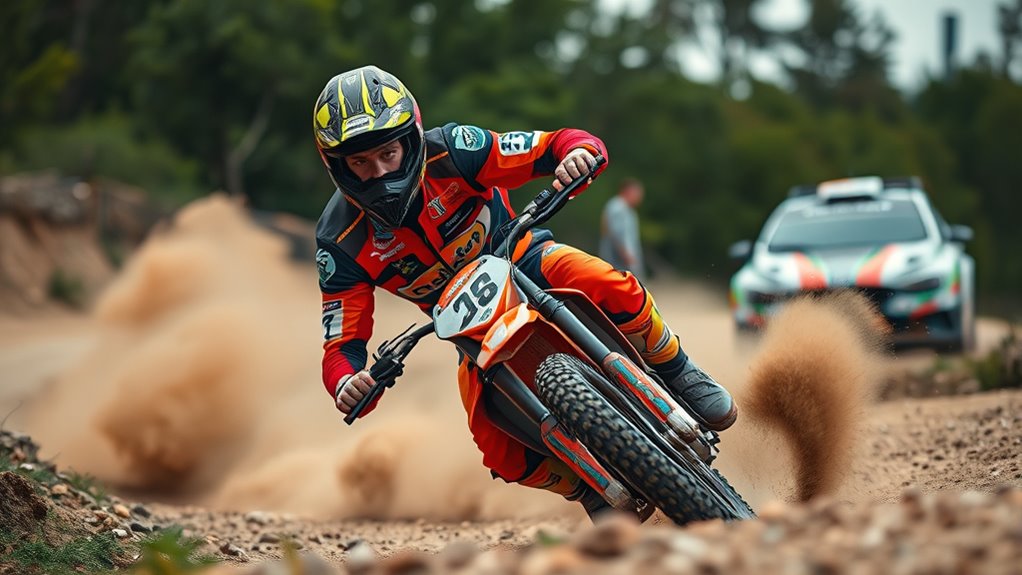
Maintaining sharp mental focus during a rally is essential for making quick, accurate decisions under pressure. You train your mind to stay alert by practicing mindfulness and visualization techniques, helping you stay present in high-stakes moments. Developing strong decision-making strategies involves analyzing situations rapidly and trusting your instincts. You learn to prioritize reactions that keep you safe and maintain pace, avoiding hesitation that can cost valuable seconds. Mental drills, such as scenario-based exercises, improve your ability to adapt to unexpected changes on the course. Staying calm under pressure allows you to process information efficiently and choose ideal paths swiftly. Regular training with high-pressure scenarios enhances your reaction time and decision-making skills, sharpening your overall performance. Staying calm under pressure allows you to process information efficiently and choose ideal paths swiftly. Consistent mental training sharpens your focus, enhances your reaction time, and ultimately keeps you ahead of competitors.
Frequently Asked Questions
How Often Should Rally Drivers Practice Reaction Time Drills?
You should practice reaction time drills regularly to stay sharp behind the wheel. Ideally, incorporate these exercises into your weekly training schedule, aiming for at least 3-4 sessions per week. Consistency helps improve your reflexes and decision-making speed. Mix in different drills to challenge your senses and adapt to various situations. The more consistent you are, the quicker you’ll react during high-pressure rally moments.
What Specific Equipment Is Used in Reaction Training?
In reaction training, you use equipment like light boards, where you respond to flashing lights, and reaction timers to measure your speed. You might also use specialized apps or devices that present sudden visual or auditory stimuli. Sometimes, you’ll practice with sports-specific gear, like steering wheel controllers or obstacle courses, to simulate real rally conditions. This equipment helps sharpen your reflexes and improves your response times under pressure.
How Do Weather Conditions Affect Reaction Training Effectiveness?
Ever wondered how weather impacts reaction training? You’ll find that rain, fog, or snow make training more challenging, forcing you to adapt quickly and sharpen your reflexes. Poor visibility and slick surfaces slow your response times, making practice more realistic for rally conditions. Embracing these conditions helps you develop better judgment and faster reactions, so you’re ready for any weather on race day. Adaptability becomes your secret weapon.
Can Reaction Time Training Prevent Crashes During Races?
Reaction time training can substantially reduce your chances of crashing during races. By practicing quick decision-making and reflexes, you improve your ability to respond swiftly to unexpected obstacles or changes on the track. While it doesn’t eliminate all risks, consistent reaction training makes you more alert and adaptable, helping you react faster in critical moments. This heightened awareness and speed can be the difference between a safe race and a crash.
How Do Young Drivers Develop Their Reaction Skills Early?
Think of developing reaction skills like sharpening a sword—you want it ready for any challenge. As a young driver, you start by practicing in simulators and controlled environments, honing your reflexes through quick decision-making drills. Engaging in diverse driving scenarios, you build muscle memory and mental agility. Regularly analyzing your performance helps identify areas for improvement, ensuring you’re always prepared to respond swiftly and safely on the road or track.
Conclusion
By incorporating these training methods, you can markedly sharpen your reaction time, just like professional rally riders do. While some believe intense physical and mental exercises alone boost reflexes, research suggests that a combination of simulator practice and focused decision-making drills yield the best results. So, don’t just rely on instinct—train it. With consistent effort, you could enhance your reaction speed and make split-second decisions that could be the difference between victory and failure.
